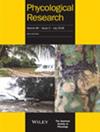卡氏甲藻甲藻(Asterodinium gracile)异常质体的甾醇:在化学分类学上与产生两性甾醇的Amphidinium carterae重叠
IF 1
4区 生物学
Q2 MARINE & FRESHWATER BIOLOGY
引用次数: 0
摘要
摘要 双鞭毛藻具有丰富的膜强化甾醇特征,其结构多样性和化学分类学用途在其他藻类中并不多见。卡伦藻科也不例外,它们产生的甾醇通常含有Δ8(14)核不饱和度,这在大多数其他甲藻类中是罕见的。我们实验室的一个持续目标是研究以前未定性的甲藻的固醇,以评估它们与其他甲藻纲成员相比基于固醇的化学分类学。Kareniaceae 的成员 Asterodinium gracile 直到最近才可以通过商业途径进行研究。为此,我们的目标是描述 A. gracile 的固醇特征,以确定它们是否与 A.我们的目的是鉴定 A. gracile 的固醇,以确定它们是否与 4α-甲基取代的 Δ8(14)-核不饱和固醇(如 (24R)-4α-methyl-5α-ergosta-8(14),22-dien-3β-ol (gymnodinosterol; C29:2) 和 27-去甲-(24R)-4α-甲基-5α-ergosta-8(14),22-dien-3β-ol (brevesterol; C28:2))相匹配:2),或者是其化学分类学上非典型、但系统发育关系最近的亲缘种--卡氏乳突藻(Karenia papilionacea)的 4-去甲基甾醇,如 27-去甲-(24R)-23-甲基麦角甾-8(14),22-二烯-3β-醇(C28:2)。我们观察到 A.gracile 产生两种 4α-甲基取代的甾醇,其结构为 4α-甲基-5α-ergosta-8(14)-en-3β-ol(C29:1)和 4α-甲基-5α-ergosta-8(14),24(28)-dien-3β-ol(amphisterol,C29:其中包括常见的甲藻甾醇胆甾-5-烯-3β-醇(胆甾醇,C27:1),但不包括庚二酮醇(gymnodinosterol)或蒲公英甾醇(brevesterol)(与大多数典型的卡伦藻科植物相同),也不包括 27-去甲-(24R)-23-甲基麦角甾-8(14),22-二烯-3β-醇(见于 K. papilionacea)。papilionacea)中发现的)。两性甾醇和 4α-甲基-5α-麦角甾-8(14)-烯-3β-醇的检测结果值得注意,因为它们是与两栖类中的某些物种(如车轴两栖类)相关的甾醇,而且据我们所知,以前从未在卡列伊科植物中观察到过。在 A. gracile 中发现这些主要固醇扩大了我们对卡伦阿斯科植物产生的固醇范围的了解,并表明它们与 Amphidinium 的某些种类具有共同的化学分类学。本文章由计算机程序翻译,如有差异,请以英文原文为准。
Sterols of the aberrant plastid, Kareniacean dinoflagellate Asterodinium gracile: Chemotaxonomic overlap with amphisterol‐producing Amphidinium carterae
SUMMARYDinoflagellates have a rich history of characterization of their membrane‐reinforcing sterols because of a structural diversity and chemotaxonomic utility uncommon to other classes of algae. The Kareniaceae are no exception in that they produce sterols, often containing a Δ8(14) nuclear unsaturation, which are rare in most other dinoflagellate groups. A continuing goal of our laboratory is to examine the sterols of previously uncharacterized dinoflagellates to assess their sterol‐based chemotaxonomy compared to other members of the Dinophyceae. Asterodinium gracile , a member of the Kareniaceae, has not been commercially available for study until recently. To this end, our objective was to characterize the sterols of A. gracile to determine whether they match the 4α‐methyl‐substituted, Δ8(14) ‐nuclear‐unsaturated sterols, such as (24R )‐4α‐methyl‐5α‐ergosta‐8(14),22‐dien‐3β‐ol (gymnodinosterol; C29:2 ) and 27‐nor ‐(24R )‐4α‐methyl‐5α‐ergosta‐8(14),22‐dien‐3β‐ol (brevesterol; C28:2 ), of most species within the canonical genera Karenia , Karlodinium and Takayama, or instead the 4‐desmethyl sterols, such as 27‐nor ‐(24R )‐23‐methyl‐ergosta‐8(14),22‐dien‐3β‐ol (C28:2 ), of its chemotaxonomically atypical, yet closest phylogenetic relative, Karenia papilionacea . We have observed A. gracile to produce two 4α‐methyl‐substituted sterols with the suggested structures of 4α‐methyl‐5α‐ergosta‐8(14)‐en‐3β‐ol (C29:1 ) and 4α‐methyl‐5α‐ergosta‐8(14),24(28)‐dien‐3β‐ol (amphisterol, C29:2 ), as major sterols amongst five other minor sterols, which included the common dinoflagellate sterol cholest‐5‐en‐3β‐ol (cholesterol, C27:1 ), but did not include gymnodinosterol or brevesterol (as in most canonical Kareniaceae) or 27‐nor ‐(24R )‐23‐methyl‐ergosta‐8(14),22‐dien‐3β‐ol (as found in K. papilionacea ). Detection of amphisterol and 4α‐methyl‐5α‐ergosta‐8(14)‐en‐3β‐ol is notable because they are sterols associated with some species of Amphidinium , such as Amphidinium carterae , and, to our knowledge, have not been observed in a member of the Kareniaceae before. Discovery of these major sterols in A. gracile expands our knowledge of the range of sterols produced by the Kareniaceae and indicates a shared chemotaxonomy with some species of Amphidinium .
求助全文
通过发布文献求助,成功后即可免费获取论文全文。
去求助
来源期刊

Phycological Research
生物-海洋与淡水生物学
CiteScore
3.60
自引率
13.30%
发文量
33
审稿时长
>12 weeks
期刊介绍:
Phycological Research is published by the Japanese Society of Phycology and complements the Japanese Journal of Phycology. The Journal publishes international, basic or applied, peer-reviewed research dealing with all aspects of phycology including ecology, taxonomy and phylogeny, evolution, genetics, molecular biology, biochemistry, cell biology, morphology, physiology, new techniques to facilitate the international exchange of results. All articles are peer-reviewed by at least two researchers expert in the filed of the submitted paper. Phycological Research has been credited by the International Association for Plant Taxonomy for the purpose of registration of new non-vascular plant names (including fossils).
 求助内容:
求助内容: 应助结果提醒方式:
应助结果提醒方式:


